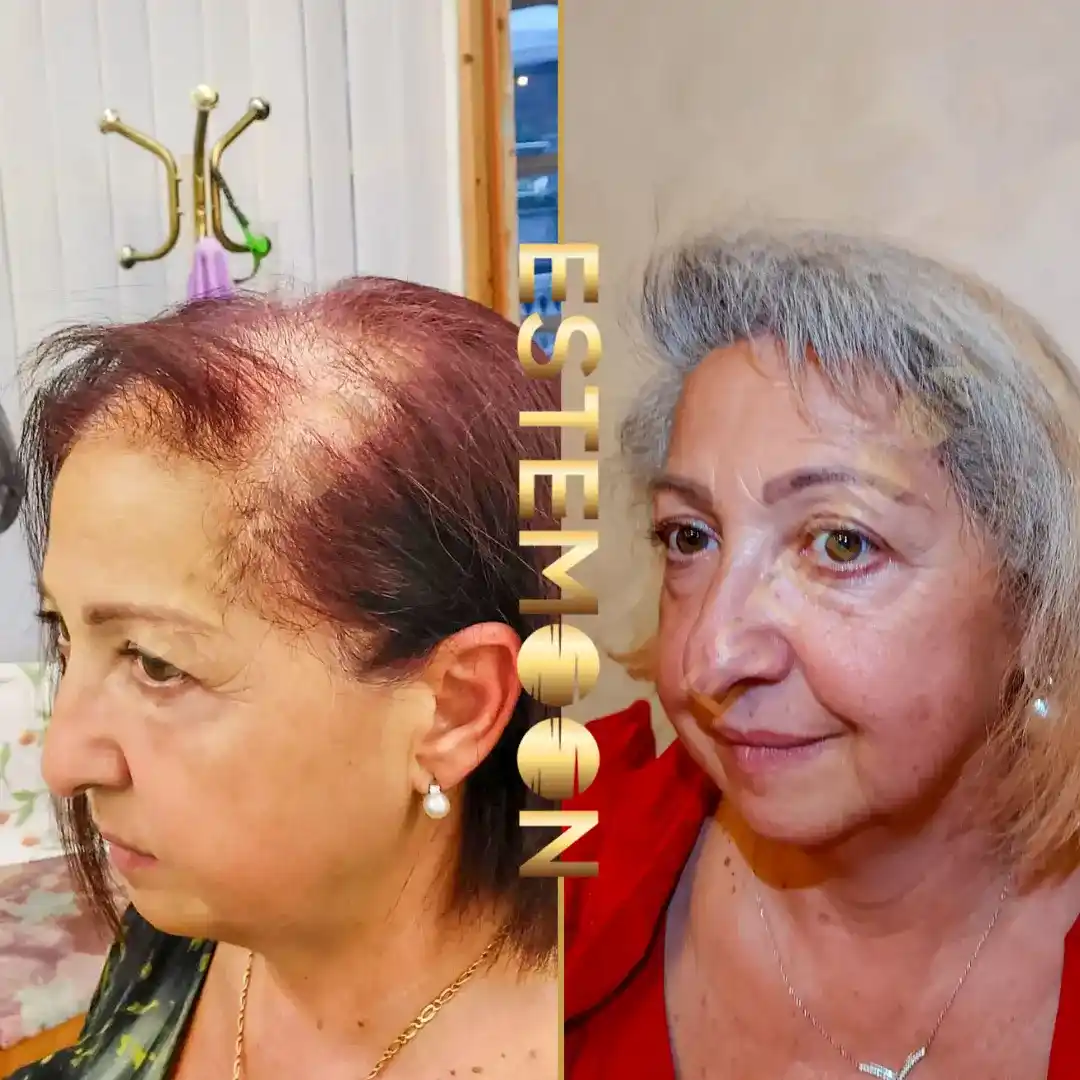Female Hair Transplant in Turkey
- Home
- Woman Hair Transplant in Turkey
The Causes of Female Hair Loss
Hair loss in women can occur for various reasons including hormonal imbalances, stress, nutritional deficiencies, aging, and certain medical conditions like thyroid disease or PCOS. While hair thinning is a natural part of aging, sudden or severe hair loss can significantly impact a woman’s confidence and quality of life.
Understanding Triggers
Androgenetic alopecia is the most common type of hair loss in women. It often presents as a gradual thinning at the crown or top of the scalp. Identifying the root cause is key to choosing the right hair restoration treatment. In many cases, treating the underlying medical condition or deficiency may slow or halt hair loss, and in others, a surgical solution like a transplant may be the best option.
Table of Contents
Female Hair Transplant
A female hair transplant is a cosmetic surgical procedure where healthy hair follicles are moved from a dense area (usually the back of the scalp) to thinning or balding regions. It’s a safe and effective solution for women experiencing hair loss that does not respond to medication.
Natural Restoration
Female hair transplant in Turkey is growing in popularity due to its affordability and natural-looking results. Leading Turkish clinics specialize in designing hairlines that complement feminine facial features. Many international patients choose Turkey not only for its medical expertise but also for its all-inclusive packages that combine healthcare and tourism.
How do Female Hair Transplants Work?
The procedure involves extracting individual hair grafts and implanting them into the recipient area. Local anesthesia is used, making the process painless. The implanted hairs begin to grow like natural hair after a few months.
Process Breakdown
- Consultation and scalp analysis
- Donor area selection
- Graft extraction
- Implantation
- Recovery and aftercare Clinics offering female hair transplant in Turkey follow internationally approved protocols to ensure success. The entire process is typically completed in a day, with patients returning to their hotels shortly after the procedure.
The Latest in Hair Replacement and Restoration for Women
Today’s techniques go far beyond wigs and topical treatments. Advanced methods like FUE, DHI, and Sapphire FUE allow for permanent, natural results with minimal downtime.
Innovations in Transplant
New technologies such as robotic assistance and platelet-rich plasma (PRP) therapy enhance hair follicle survival rates and accelerate healing. These cutting-edge solutions are commonly used in Turkish clinics to improve overall outcomes.
Impact of Hair Loss on Women
Hair is strongly tied to identity and femininity. For many women, hair loss causes emotional distress, anxiety, and low self-esteem. Addressing the issue can significantly improve mental health and social confidence.
Psychological Effects
Women may feel embarrassed or avoid social settings due to thinning hair. A successful transplant can reverse these feelings and restore self-assurance. For many, hair restoration is not just physical but also emotional healing.
Hair Restoration for Women: Candidacy and Factors
Not every woman is a candidate for a hair transplant. A consultation is necessary to assess factors like the type of hair loss, donor hair quality, scalp condition, and overall health.
Candidacy Checklist
- Stable donor area
- Diagnosed pattern hair loss
- No active skin conditions
- Realistic expectations In Turkey, clinics provide comprehensive evaluations to ensure safe outcomes. It is essential that candidates understand the process and commit to post-operative care.
Free Consultation
Female Hair Transplant in Turkey
Before and After


Female Hair Transplant Techniques
The most common techniques used for women include:
- FUE (Follicular Unit Extraction)
- DHI (Direct Hair Implantation)
- Sapphire FUE Each method has its benefits depending on the hairline shape, thinning pattern, and graft requirement.
Choosing the Right Method
Female hair transplant in Turkey clinics tailor the technique to your specific goals and anatomy for the most natural appearance. Surgeons take into consideration the direction of hair growth and the individual’s lifestyle when planning the procedure.
Preparation For Hair Transplant Procedure
Preparation includes both physical and logistical steps. Patients are advised to stop smoking, avoid alcohol, and pause certain medications at least one week before the surgery.
What to Do Before Surgery
- Eat a light breakfast on the day
- Wash your hair with clinic-approved shampoo
- Wear buttoned clothing to avoid rubbing the scalp Preoperative guidance ensures better healing and results. Proper preparation also reduces the risk of complications and enhances graft survival.
What are the Benefits of Hair Transplant
A hair transplant offers long-term, low-maintenance solutions to thinning or bald spots. Unlike temporary fixes, it restores your own natural hair permanently.
Key Advantages
- Improved hair density and volume
- Enhanced confidence
- Custom-designed hairline
- Eliminates need for wigs or extensions The result is not only cosmetic but also psychological, helping women feel more in control and confident.

All-Inclusive Hair Transplant Package 📝


📌 Operation with FUE Sapphire / DHI technique (by the Doctor)
📌 2 Plasma/PRP injection
📌 Blood test (before surgery)
📌 Medications after surgery (stomach protector, painkillers, anti-swelling, antibiotics, cream)
📌 Special shampoo and lotion (special formula from the Istanbul Care laboratory).
📌 Medical neck pillow
📌 Medical check-up (after transplant)
📌 Hair washing (by our doctor after the operation)
📌 Lunch on the day of the operation
⚡️Accommodation: Hotel 2 nights (breakfast included)
⚡️VIP transport (Airport-Hospital-Hotel)
⚡️Guarantee Certificate 📑
⚡️Personal translator
⚡️Follow-up and support for 1 year
⚡️1 companion included
🌟 News 🌟: TREATMENT WITH STEM CELLS
🌟 News 🌟: RED LIGHT THERAPY
What is not included:
❇️ Plane ticket+
What are the Stages of the Women Hair Transplant Method in Turkey?
- Medical consultation and diagnosis
- Preoperative instructions and tests
- Surgery day – anesthesia, extraction, implantation
- Post-op recovery and follow-up
- Long-term care and assessment
Step-by-Step Excellence
Turkey’s clinics provide step-by-step guidance and multilingual support for international patients. Each phase is monitored to ensure that the patient is comfortable, informed, and achieving optimal results.
Expected Results for Female Hair Transplant
Initial results begin to show at around 3–4 months. Full density and natural hair growth are typically achieved between 9 and 12 months post-transplant.
Realistic Outcomes
Hair growth occurs gradually, blending with your existing hair. The final look is permanent and low-maintenance. Results vary slightly depending on the patient’s age, health, and adherence to aftercare.
Expert Women’s Hair Loss Treatment in Turkey
Turkey is home to top-rated hair restoration centers offering specialized services for women. Clinics employ female consultants and multilingual staff to ensure a comfortable experience.
Why Turkey?
With affordable pricing, advanced technology, and skilled surgeons, female hair transplant in Turkey is one of the best choices for international patients. The country has earned a global reputation for excellence in cosmetic procedures.
How Long Does it Take to Perform a Female Hair Transplant?
Most procedures take between 6–8 hours depending on the number of grafts. Patients are usually discharged the same day with aftercare instructions.
Influencing Factors
- Technique used (FUE, DHI)
- Number of grafts
- Size of the thinning area Clinics in Turkey prioritize both comfort and precision during the session. Breaks and meals are usually arranged to make the day as relaxing as possible.
Different Types of Female Hair Transplant
Depending on the area of concern, hair transplants for women can be categorized as:
- Crown density enhancement
- Hairline reconstruction
- Temple filling
- Eyebrow transplant Each type requires a unique approach to achieve symmetry and realism. Turkish clinics offer customization for all types of hair and scalp conditions.
What Hair Transplants Do We Offer For Women?
Clinics in Turkey offer customized packages including:
- FUE or DHI procedures
- PRP therapy
- Hairline design
- Pre- and post-care consultation These services are tailored specifically to women’s needs and expectations. Packages may also include transportation, accommodation, and translation services.
Why Get a Female Hair Transplant?
A hair transplant restores volume, density, and confidence. It’s ideal for those tired of temporary solutions and looking for long-term, natural outcomes.
Empowerment Through Restoration
Many women choose a transplant to reclaim their identity and reduce dependence on hairstyling products or concealers. It’s a life-changing decision that brings lasting benefits.

How is a Female Hair Transplant Performed?
After numbing the donor and recipient areas with local anesthesia, grafts are extracted and implanted using micro-surgical tools. The procedure is pain-free and performed under sterile conditions.
Surgical Precision
Technicians and doctors in Turkey use modern tools to implant each hair at a specific angle and direction to mimic natural growth. The entire process is completed with care and accuracy.
How Much Does a Female Hair Transplant Cost in Turkey?
On average, the cost ranges from €1,500 to €2,500. Many clinics offer inclusive packages covering consultation, surgery, hotel stay, and airport transfers.
Transparent Pricing
Compared to Europe or the US, Turkey offers up to 70% cost savings without compromising on quality. Payment plans and group discounts are also available in some clinics.
Recovery Period Following a Female Hair Transplant?
Initial redness and scabbing subside in 7–10 days. Patients can resume light activities after 3 days but should avoid sweating or sun exposure for 2 weeks.
Recovery Timeline
- Day 1–3: Mild swelling, start medications
- Day 7–10: Scabs fall off
- Month 3: New hair begins to grow
- Month 12: Final results visible Ongoing follow-ups help track progress and address any post-surgical concerns.
Hair Transplants for Black Women
Hair texture and follicle curvature are different in Black women. Clinics in Turkey have experience in customizing techniques to ensure successful outcomes for textured hair.
Special Considerations
- Gentle extraction methods
- Angle adjustments for curl patterns
- Specialized aftercare These tailored methods ensure that the results look natural and are long-lasting.
Frontal Hairline Female Hair Transplant
The hairline frames the face and requires meticulous planning. Transplants in this area must be carefully designed to maintain a soft, feminine look.
Designing the Hairline
Turkish surgeons consider face shape, forehead height, and age when planning the perfect hairline for women. Special tools are used to measure and map each placement accurately.
Female Hair Transplant Risks & Complications
While rare, risks include infection, swelling, poor graft survival, or unnatural hairline if not done properly.
Risk Reduction
Choosing an accredited clinic with experienced surgeons greatly reduces complications. Follow-up care ensures graft success. Patients are encouraged to follow instructions precisely to avoid complications.
Women’s Hair Loss and the Pill
Hormonal birth control pills can affect hair growth. In some women, stopping or starting the pill may trigger hair shedding due to hormonal fluctuations.
Consultation Required
Always inform your doctor about medication use, as hormone-related hair loss may require a different treatment plan before considering a transplant. A personalized approach leads to better outcomes.
FAQs About Women Hair Transplant in Turkey
What is a female hair transplant and how does it work?
A female hair transplant is a surgical procedure where healthy hair follicles are transplanted to thinning or balding areas. It uses FUE or DHI techniques and provides natural, permanent results.
Why choose Turkey for a female hair transplant?
Turkey is known for its skilled surgeons, advanced technology, and affordable packages. Clinics offer expert care, especially for international female patients.
How much does a female hair transplant cost in Turkey?
Prices typically range from €1,500 to €2,500, depending on graft count and technique used. Packages often include hotel, airport transfers, and aftercare.
Is a female hair transplant painful?
No, the procedure is done under local anesthesia. Patients experience little to no pain, and any discomfort afterward is managed with medication.
When will I see results after a hair transplant?
New hair starts growing at 3–4 months. Final results, including full density and coverage, appear between 9 and 12 months post-surgery.
Are there risks or side effects for women getting a hair transplant?
Risks are minimal when performed by experienced surgeons. Possible side effects include swelling or minor infection, which are temporary and treatable.
